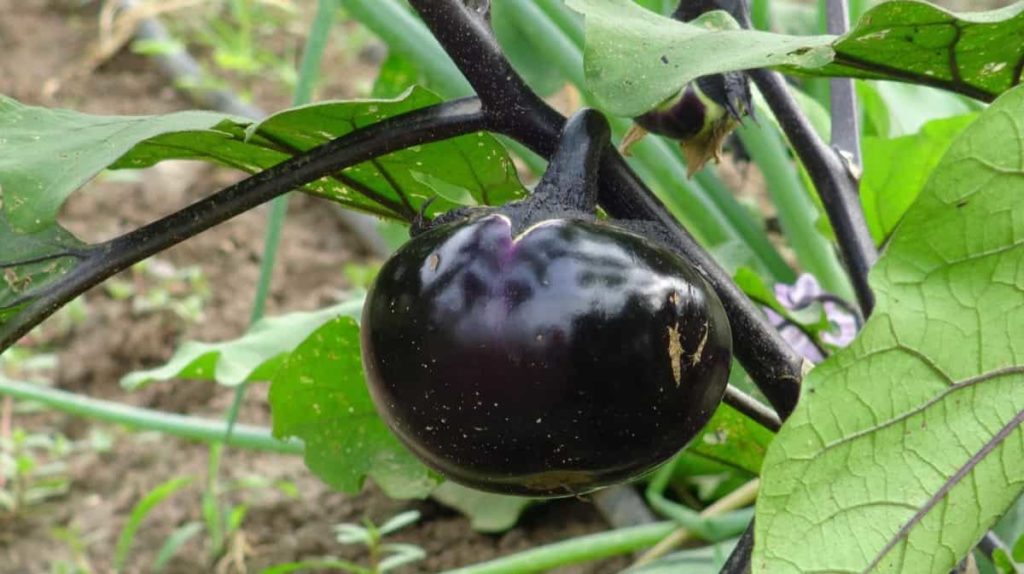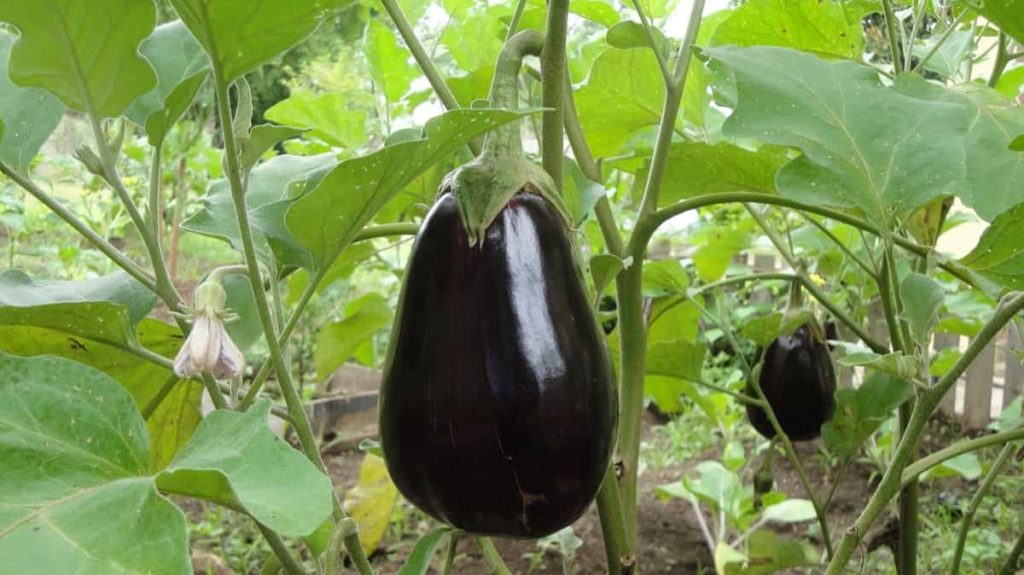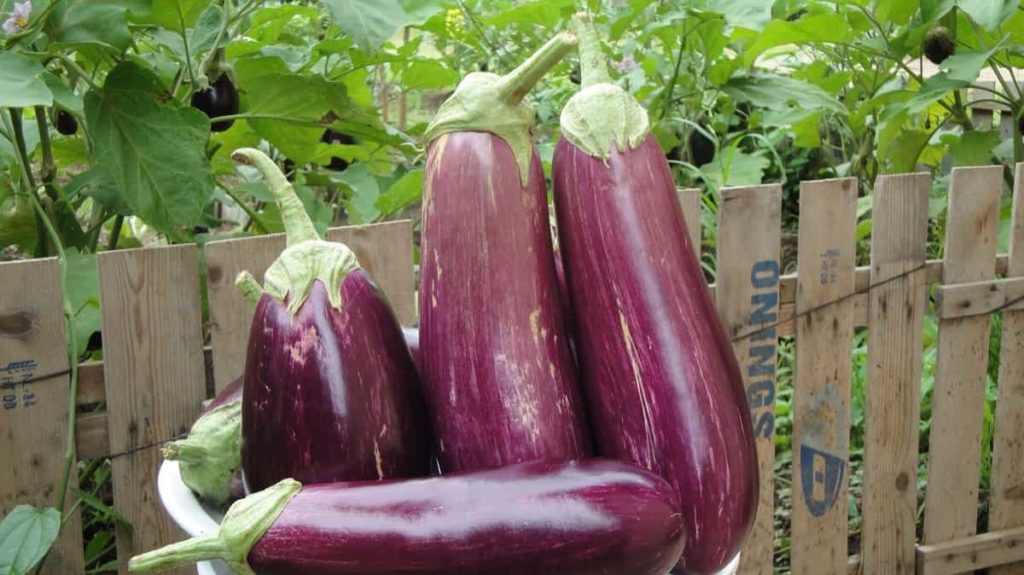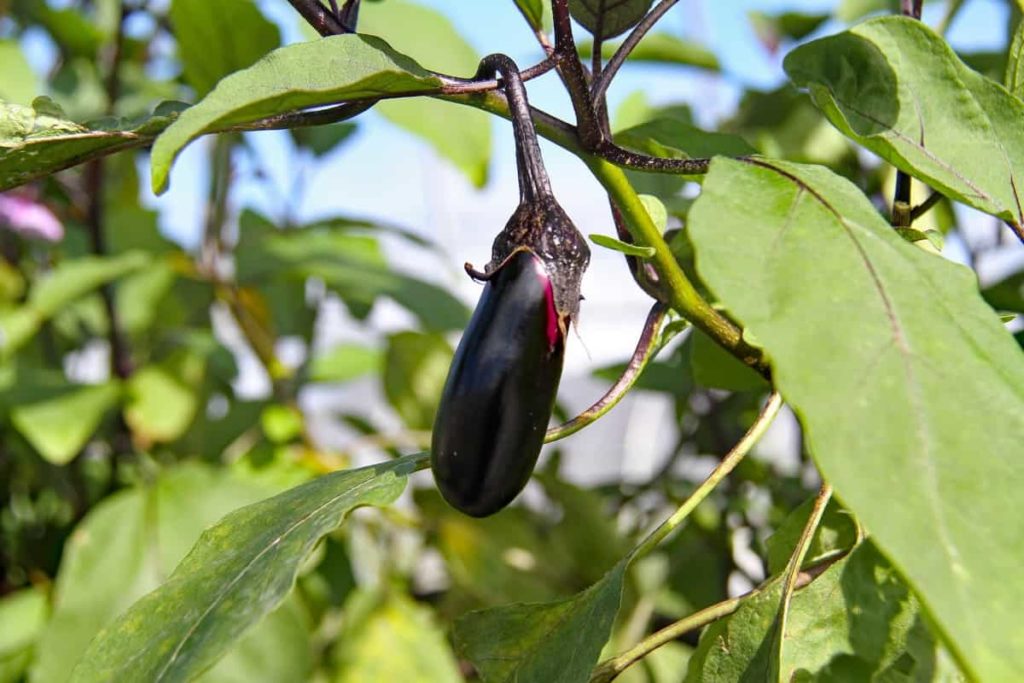Solanum melongena L is the scientific name given to brinjal. Referred to as ‘eggplants’ in countries other than the Indian sub-continent, brinjals are one of the most commonly consumed vegetables in the world. These are extensively grown in tropical and subtropical regions, mainly in the countries of India, Bangladesh, China, and Pakistan. Here are the best practices to grow Brinjal/Eggplant at home.

Eggplants or brinjals are easy to cook and taste very well, even when the recipe followed may not be accurate. That is one of the reasons it is lovingly called the king of vegetables in India. It can be combined with any vegetable and is deliciously cooked without worrying about the end taste. In European and other foreign countries, eggplants are considered one of the varieties people’s they harvest.
Though brinjal has many reasons to be the people’s favorite vegetable, there are enough reasons to avoid consuming it regularly. While most causes are similar for eggplants and other nightshade vegetables, the primary reason for not favoring brinjals is the presence of a chemical named Solanine, which can worsen Arthritis and other similar diseases. Though this statement about Solanine is not strongly proven, it is highly advised not to be consumed too often.
After the whole world hit the pandemic, people on a large scale started farming at home in their backyards or on farms trying to eat clean and healthy. Though reasons are strong enough not to consume eggplants often, they can be consumed occasionally. Below are some common queries related to farming eggplants or brinjals at home.
Best practices to grow Brinjal/Eggplant at home
How can I grow brinjal at home?
Home farming of brinjal can be achieved by using pots. The traditional way uses seeds to grow brinjal plants from the initial stage. Seeds are either bought from the seed shop vendors or the dried-up eggplants. Another way is to use already developed seedlings available from the nursery and plant them in already setup soil with conditions favorable for ideal growth of brinjal.
For beginners, growing the brinjal plants with the help of seedlings is recommendable as it requires less effort and can be carried out without much trouble. However, for experts or experienced people, the way of growing can be their own choice or might be the effect of the prevailing weather conditions or other factors.
In case you missed it: Eggplant Farming (Brinjal) Information Guide

How long does brinjal take to grow?
As brinjal is an eggplant, it grows in a fashion similar to a baby’s growth. From the beginning of the plantation, the growth of eggplant takes around 100-120 days on average to attain the maturity stage. Depending upon the variety of eggplant which is planted and the month of the plantation, the harvesting period and month can be determined.
Usually, it takes four months to harvest from the date of planting. Earlier harvesting of eggplant makes them taste better; the later the harvest gets, the worse the taste gets. So, according to the weather and plantation month, harvesting must be planned accordingly.
Which is the best month to grow brinjal?
As brinjal is most favorable to warm conditions, the winter’s period of the beginning of the plantation can be just after the fall or right after the winter’s end. In India, the perfect month to start brinjal growing is either the end of January or the month of February. The reason is 120 days ideal maturity time of brinjal plants. Therefore, if the seed is planted in those months, the ideal harvesting time will be the end of April or the month of May.
How much brinjal can one acre produce?
The average yield obtained from an acre of farming land is around 10,000 kilos. In a year, depending upon the soil purity, productivity, climatic conditions, water nourishment, and all other contributing factors, a farmer or the landowner can do three to four harvesting per year. Naturally, the area of spread has to be utilized to the maximum extent but limits or constraints like the variety of eggplant used, the nature of the soil and its pH value, and other conditions remain and affect the productivity rate.
What is the lifespan of brinjal plant?
Eggplants are usually perennial and last for three years maximum, where the plant’s productivity diminishes to lower than threshold levels. Then, it needs to be removed and replaced with a high-yielding plant. In general circumstances, eggplants are removed after one year to maintain the ideal cases, and the productivity of the soil can be kept undisturbed.
Does brinjal need full sun?
Brinjal is a warm-season vegetable and requires a lot of sun exposure to survive and yield. This requirement is why the plantation of brinjal is done, particularly in such conditions that the weather provides a lot of sun exposure, and the arrangement of the pot or yard where the brinjal is planted should ensure an adequate amount of sunlight is falling on the plant. Without proper sun exposure, brinjal cannot be expected to grow to its full potential.
In case you missed it: Growing Tomatoes Tips and Tricks

How much water do eggplants need?
Eggplants usually require less water to grow as they mostly favor dry and warm conditions. But, even then, any plant needs water to grow and perform photosynthesis. The ideal amount of water required is around 1 inch above the soil level per week. And this water supply is better to be given once a week rather than watering it daily. The reason behind this is that daily watering may lead to shallow roots, and the growth might be hindered due to this. So, ideally, watering is recommended once a week to keep the development undisturbed.
How can we increase the yield of brinjal?
Because brinjal doesn’t-duration crop, the yield can be increased by providing better manure and trying to keep the soil as fertile as possible, ensuring it doesn’t lose its productivity. Also, the usage of fertilizers makes a significant impact on the yield of the plant. Depending upon the weather conditions and water supply, the dose of fertilizers may be either increased or decreased. On average, for an acre of a farm, 17-20 tonnes of FYM manure is used in the soil to increase productivity.
Which is the tastiest brinjal?
There are many varieties of eggplants and they are all tasty, the very reason why Indians call it the king of vegetables. However, out of those varieties, the Rosa Bianca variety is said to be the tastiest. The variant grows more in the shape of a gourd, long like a tube. These are not so thick and are known to taste best when grilled or fried in slices.
What type of soil is best for eggplant?
Eggplants are best productive in dry soil that can drain well without having any clogging or water retention as this may give rise to undesired bacteria and can disturb both the growth of the plants and can spoil the soil. For best practice, composts are spread over 3-4 layers down the soil after 6 layers of clay or sandy soil. Lome soil can be preferred as it is best suitable for most varieties of vegetables. Also, the soil’s acidic nature can contribute to the eggplant’s growth. The ideal pH is 5-7, which can be described as slightly acidic or neutral.
Can we grow brinjal in pots?
Brinjal is very feasible to be grown in pots. However, Brinjal plants need a good amount of space to grow. Usually, a big pot that can provide a distance of 3 feet around the plant can best suit the requirement. In addition, Brinjal plants grow as small bushes, so there needs to be space for the roots to grow into the soil.
In case you missed it: Growing Potatoes In Containers Information

Can eggplants get too much sun?
No, eggplants cannot tolerate too much sun. Though they require full sun to grow and thrive, that doesn’t stop them from being overdosed by sunlight and the burn. If the eggplants are exposed to the sun for more than tolerable durations, they burn and yellow spots of burn appear on the eggplants. Ideally, a temperature of around 32 to 35 degrees is enough for the eggplant to thrive. Crossing this temperature range would have adverse effects on the plant, which would be evident in the leaves and flowers.
How long does it take for the eggplant to bear fruit?
If proper manure and nourishment are ensured, eggplant plants bear fruit after 65-70 days from seed sowing. This duration is different for various varieties of eggplants. In general, most varieties of eggplants take 100-120 days to attain the ideal harvesting stage. Most of the time, harvesting of the brinjal farm is started after 70-80 days, and the eggplants are harvested as and when they are grown enough.
What is the fastest way to germinate brinjal seeds?
Brinjal seeds can be germinated by placing them in loosely packed soil. The seeds are taken and planted to a depth of a quarter inch into the soil and are placed in a warm spot. Adequate water and moisture are ensured even though water is drained out in time. These packs are either placed in the warm spot of a refrigerator or in the sunlight, ideally for 6 hours a day.
How many eggplants do you get per plant?
One plant can average yield 5-7 eggplants in one harvest. This can again vary from variety to variety and location of cultivation. Other factors like soil fertility, manure provided, and seed quality also impact the plant’s yield.
In case you missed it: Black Pepper Cultivation Information Guide

What is the procedure to plant brinjal at home?
Ideally, loam soil or clay soil is used to grow brinjal. The first step is to germinate seeds by placing them in loosely packed covers or bags and placing them in sunlight for hours a day. The seedlings start showing up for 2-3 days. After the seedlings are obtained, they are placed in the soil at 2 to 3 inches. The surroundings are selected so that sunlight falls on the plants for at least 7-8 hours a day.
Water is provided once a week till 1 inch above the soil once a week. Daily watering is not recommendable as it reduces the growth of roots, affecting the plant’s health. After 70-80 days from seeding, the eggplant starts flowering. The flowers of the brinjal plant are self-pollinating, but cross-pollination is done to increase the growth rate and enhance productivity. The flowers develop new eggplants in 60-70 days, and they grow into fully grown vegetables ready to be harvested.
Conclusion
These are some of the common queries about growing brinjal at home. Eggplants or brinjal are one of the most consumed vegetables of India and surrounding countries. The primary reason is the taste, but adding to that, the fact that it is so easy to be cooked and can be combined with any vegetable without having to worry about the taste is also a reason for its usage. There are many varieties of eggplant, and they are all grown similarly, owing to the farming practices of the particular location.
In case you missed it: How Swaraj Tractors Helping Indian Agriculture: Price, Models, and Dealers.

Due to their colorful skin, eggplants made natural dye in ancient days, which was used to color teeth. Though eggplants are said to worsen Arthritis and similar health complications, they have their share of vitamins A and C too, which can strengthen the immune system and aid better sugar processing by the body in the case of diabetic patients. Also, brinjal contains special enzymes that can stimulate the follicles of hair and promote hair growth. The juice of eggplants can be used on hair to give shine and a glossy, silky look too.
- How to Raise Pigs in Your Own Backyard: A Comprehensive Guide
- Budget Friendly Sheep Shed Ideas: Cheap and Low-Cost Tips
- How Much Do Cattle Farmers Make: Revenue Streams in Cattle Farming
- Management Pests and Diseases in Your Cotton Field
- Sheep Farming Business Plan for Beginners
- Aquaponic Farming at Home: A Step-By-Step Guide
- Profitable Village Farming Business Ideas in 2024
- High-Yield Aquaculture: Fast-Growing Fish for Farming
- Effective Fish Pond Construction Techniques for Beginners
- Irrigation and Water Management in Pineapple Farming
- Blossom to Harvest: Mastering Flowering and Pollination in Papaya Farming
- Pig Fattening Essentials: From Selection to Sale for Beginners
- Raising Wagyu Cattle: A Complete Guide for Premium Beef Production
- Soil Types and Their Water Holding Capacity
- Optimizing Irrigation Schedules for Coconut Groves for Enhanced Yield
- Espresso Your Garden: Coffee Grounds for Healthier Acid-Loving Plants
- The Best Soil Mix for Snake Plants: How to Mix Your Own Snake Plant Soil
- Green Thumb Success: Expert Tips for Cultivating Greenhouse Beans All Year Round
- Bloom All Year Round: The Ultimate Guide to Indoor Hyacinth Care
- Eco-Friendly Gardening: How to Make Liquid Fertilizer from Kitchen Waste
- Ultimate Guide to Grow Anise in Pots: Explore Seed Propagation to Harvesting
- Guide to Raising Chester White Pigs: Discover Breed Facts to Growth Management
- Mastering the Elegance: The Ultimate Guide to Weeping Cherry Tree Care, Planting, and Maintenance
- Ultimate Guide to Planting Garlic in Grow Bags: Growing Strategies for Beginners
- How to Fix Spider Plant Leaf-Related Problems: Natural and Organic Remedies
- 10 Reasons Why Your Tulsi Plant is Shedding Leaves: Home Remedies and Solutions
- Optimizing Growth and Yield: The Advantages of Palm Bunch Ash Fertilizer
- Utilizing Neem Oil Extract as a Natural Pesticide for Hydrangea
- From Soil to Harvest: Various Ways in Which Farmers Can Use AI Tools
- Steps to Encourage and Induce Citrus Flowers: A Comprehensive Guide
- How to Fix Snake Plant Leaf-Related Issues: Natural and Organic Remedies
- Transform Your Garden into a Fragrant Oasis with Raat Ki Rani (Night Blooming Jasmine)
- Discover the Ideal Chicken Breeds for Philippine Farms
- How to Create a Poultry Egg Farm Business Plan for Profits
- Grow Lemon Cucumbers Like a Pro: Insider Techniques for Bountiful Yields
- Ultimate Guide to Caring for Your Pink Princess Philodendron: Tips for Thriving Variegation
